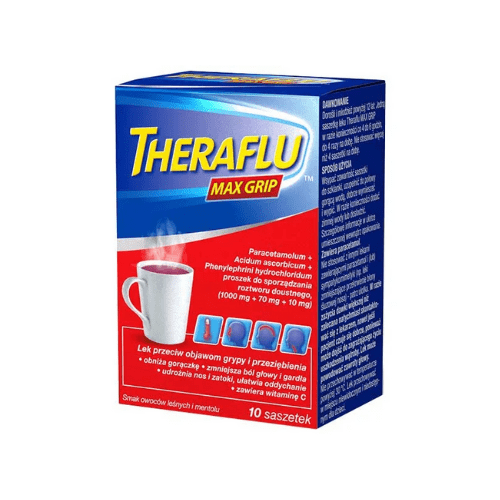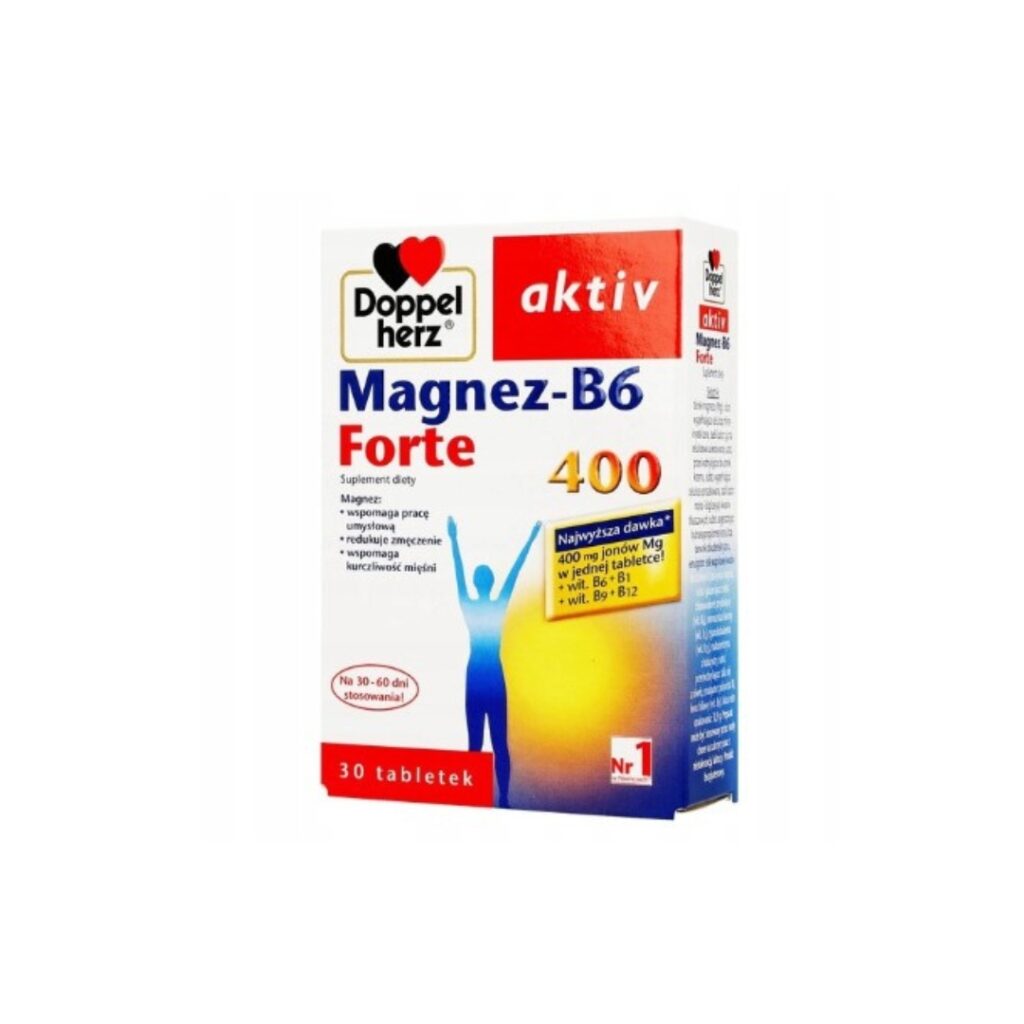Theraflu Max Grip (10 Sachets)
Theraflu Max Grip contains 3 active ingredients: paracetamol, phenylephrine and ascorbic acid (vitamin C):
- paracetamol – has an analgesic and antipyretic effect,
- vitamin C – a vitamin whose deficiencies may occur in the first days of colds and flu,
- phenylephrine – constricts blood vessels, opens the nasal passages and sinuses, making breathing easier.
INDICATIONS
Theraflu Max Grip is indicated for the short-term treatment of symptoms occurring during flu or colds: fever, headache, sore throat, nasal passages and sinus obstruction with pain. If after 3 days there is no improvement or the patient feels worse, you should see your doctor.
Active substance: Acidum ascorbicum, Paracetamolum, Phenylephrini hydrochloridum
COMPOSITION
| 1 sachet contains: | active substances: 1000 mg of paracetamol, 70 mg of ascorbic acid and 10 mg of phenylephrine hydrochloride |
| excipients: sucrose, tartaric acid, sodium citrate, aspartame, aroma of menthol and Berry Fruits Flavorburst (contains 4- (parahydroxyphenyl) -2-butanone, acetic acid, vanillin, propionic acid, 1-menthol, d-limonene, menthon , 4-carvomenthol, star anise essential oil, elderberry flower aroma, beech essential oil, Cognac white oil, sucrose, maltodextrin, modified starch E1450, sunflower oil), Euroblend Blackcurrant dye (contains Carmin E122, E141 Orange Green E141 , sodium chloride, sodium sulfate, volatile substances) |
DOSAGE
Always use this medicine exactly as described in this leaflet or as directed by your doctor, pharmacist or nurse.
Check with your doctor, pharmacist or nurse if you are not sure. Use in adults and adolescents over 12 years of age One sachet, if necessary, every 4 to 6 hours. Do not use more than 4 sachets a day. Do not exceed the recommended dosage.
Always use the lowest effective dose possible.
Method of administration
For oral use only. Before administration, the powder should be dissolved in hot water. Pour the content of one sachet into a glass, fill it up to half with hot water, mix well and drink it. If necessary, add cold water or sweeten.
Do not use more often than every 4 hours. Do not use the drug for more than 3 days without a doctor’s recommendation.
Do not give the drug to children under 12 years of age.
Use of the drug in children and adolescents
Do not give the drug to children under 12 years of age.
CONTRADICTIONS
Do not use Theraflu Max Grip:
- if you are allergic to paracetamol, phenylephrine, ascorbic acid or any of the other ingredients of this medicine
- in people taking monoamine oxidase inhibitors (MAOIs) or within 14 days of stopping treatment with such medicines,
- in people taking zidovudine
- in people diagnosed with alcoholism, angle-closure glaucoma, liver failure, severe renal failure, hyperthyroidism, diabetes, cardiovascular diseases, including heart disease, hypertension, pheochromocytoma,
- in people taking tricyclic antidepressants,
- in people taking beta-adrenergic blockers.
APPLICATION NOTES
Theraflu MAX GRIP contains sodium, sucrose, sunset yellow, carmine and aspartame:
- 1 sachet contains 5 g of sucrose. People with diabetes should include this amount of sucrose in their diet.
- Due to the content of sucrose, if the patient has been diagnosed with an intolerance to some sugars, the patient should consult a doctor before taking the drug.
- The drug contains dyes: sunset yellow (E110) and carmoisin (E122). These substances can cause allergic reactions.
- This medicine contains aspartame – a source of phenylalanine which may be harmful for people with phenylketonuria.
- 1 sachet contains 117 mg of sodium. People on a low sodium diet should include this amount of sodium in their diet
Contents
The package of the drug contains 10 sachets.
Storage
Below 30°C
Manufacturer
GLAXOSMITHKLINE
WARNINGS
The drug contains paracetamol. Overdosage of paracetamol can lead to severe liver damage. The drug should not be used simultaneously with other paracetamol-containing medicines, such as painkillers, antipyretics, medicines used to treat symptoms of flu and colds.
Do not use with other drugs containing sympathomimetics (such as nasal decongestants, appetite suppressants and amphetamine-like psychostimulants) or cold and flu medications. Read the leaflet carefully before taking the medicine and follow the instructions contained therein. Before using the drug, the patient should consult a doctor in the event of:
- liver or kidney disease. General liver problems increase the risk of liver damage from paracetamol. There is an increased risk of overdose in people with liver disease.
- patients who are underweight or malnourished, suffering from anorexia,
- patients who consume alcohol regularly
- severe infection that may increase the risk of metabolic acidosis, such as:
- deep, fast and difficult breathing,
- nausea, vomiting and / or loss of appetite
- generally feeling unwell. Contact your doctor immediately if you experience any of the symptoms described above at the same time.
- prostatic hyperplasia,
- thromboembolism, e.g. Raynaud’s syndrome (characterized by paroxysmal pain in the fingers caused by cold or emotions),
- pregnancy, suspected pregnancy or breastfeeding. Do not drink alcohol while taking this medicine because of the increased risk of liver damage.
Ingestion of 5 g of paracetamol may lead to liver damage in patients with the following risk factors:
- patients on long-term treatment with carbamazepine, phenobarbital, phenytoin, primidone, rifampicin, St. John’s wort or other drugs inducing liver enzymes,
- patients who regularly abuse alcohol,
- patients with possible glutathione deficiency, e.g. with eating disorders, cystic fibrosis, HIV infection, malnourished or debilitated patients.
If you take more than the prescribed dose, contact your doctor immediately, even if you feel well. If symptoms persist, consult a physician.
Pregnancy and lactation
Do not use the drug during pregnancy or if you think you may be pregnant or breastfeeding unless your doctor tells you to.
If you are planning to have a baby, ask your doctor or pharmacist for advice before taking this medicine.
Driving vehicles
The drug may make you feel dizzy. If affected, you should not drive or operate machinery.
Overdosage
If you take more than 4 sachets in 24 hours, see your doctor immediately, even if you have no side effects, due to the risk of delayed, severe liver damage, which may result in liver transplantation or death.
Overdosing of paracetamol may cause nausea, vomiting, excessive sweating, drowsiness and general weakness within a few to several hours. In any case of taking paracetamol in a dose of 5 g or more at a time, vomiting may be induced if it is not more than an hour after consumption and contact a doctor immediately. Give 60-100 g of activated charcoal orally, preferably mixed with water. The amount of drug that would lead to severe symptoms of overdose of phenylephrine or ascorbic acid would cause severe liver damage from paracetamol.
An overdose of phenylephrine can cause nervousness, headache, dizziness, insomnia, increased blood pressure, nausea, vomiting, irritability, restlessness, hypertension and a decrease in heart rate. In severe cases, confusion, hallucinations and arrhythmias may occur. High doses of ascorbic acid (over 3 g) can cause transient diarrhea and gastrointestinal symptoms such as nausea and abdominal discomfort.
INTERACTIONS WITH OTHER DRUGS
Tell the doctor or pharmacist about all the drugs taken by the patient now or recently, and about the drugs that the patient is planning to take. Please consult your doctor if you are taking the following medications:
- metoclopramide, domperidone (used against nausea and vomiting),
- cholestyramine (used to lower high blood cholesterol)
- anticoagulants (e.g. warfarin) if you need to use a long-term pain reliever
- sleeping pills, anti-epileptics, rifampicin (anti-tuberculosis medicine),
- MAO inhibitors (used e.g. in depression) and other antidepressants (from the group of tricyclic antidepressants),
- non-steroidal anti-inflammatory drugs (including acetylsalicylic acid),
- ergot alkaloids (e.g. used in migraine),
- some medicines for heart disease or high blood pressure (e.g. digoxin, beta blockers, methyldopa)
- the use of appetite suppressants, nasal decongestants and amphetamines derivative psycho-stimulants (e.g. used in attention deficit hyperactivity disorder).
The use of paracetamol may lead to false results in some laboratory tests (e.g. blood glucose tests). Phenylephrine may increase the blood pressure-increasing effect of drugs that speed up labor. Caffeine enhances the analgesic effect of paracetamol. Ascorbic acid increases the absorption of iron, increases the absorption of aluminum from antacids containing it.
SIDE EFFECTS
Like all medicines, this medicine can cause side effects, although not everybody gets them. Stop using the drug immediately and contact your doctor if you experience:
- an allergic (allergic) reaction such as a skin rash or itchy skin, sometimes with difficulty breathing or swelling of the lips, tongue, throat or face
- skin rash or severe skin reaction such as acute generalized pustular rash or blisters and erosions of the skin, mouth, eyes and genitals, fever and joint pain, or bursting giant epidermal blisters, extensive skin erosions, peeling and fever,
- breathing problems if you had similar problems in the past with acetylsalicylic acid or other NSAIDs
- unknown cause bruising or bleeding
- vision loss which may be caused by excessively high pressure in the eye. It is very rare, but it is likely to happen in people with glaucoma.
- an unusual fast heart rate or a feeling of irregular heartbeat
- difficulty urinating. This is more likely in men with an enlarged prostate gland • liver problems (as indicated by yellow skin and eyes, tenderness of the liver).
These reactions are rare (more than 1 in 10,000, but less than 1 in 1,000 patients) or very rare (less than 1 in 10,000 patients). Theraflu MAX GRIP may also cause the following side effects:
very rare (affecting less than 1 in 10,000 patients):
- Headache,
- dizziness,
- insomnia,
- nervousness,
- increase in blood pressure
- nausea and vomiting.
Reporting side effects
If you get any side effects, talk to your doctor, pharmacist or nurse, including any side effects not listed in this leaflet.




